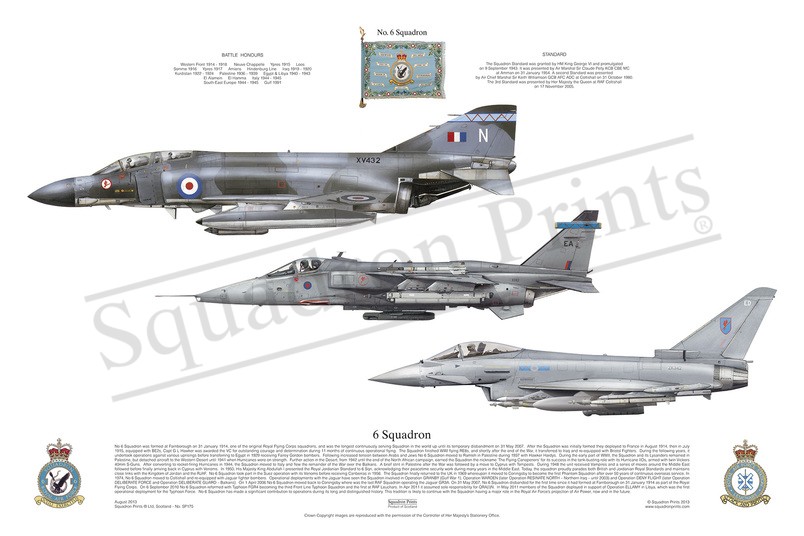#SP175 6 Squadron Triple Phantom Jaguar Typhoon

Description
Squadron Prints Lithograph No. SP175 - Phantom FGR2, Jaguar GR3A and Typhoon FGR4, 6 Squadron. This print is a Limited Edition of 200 copies only. Please note that these prints will be shipped out after Leuchars Airshow on 7th September 2013. No 6 Squadron was formed at Farnborough on 31 January 1914, one of the original Royal Flying Corps squadrons, and was the longest continuously serving Squadron in the world up until its temporary disbandment on 31 May 2007. After the Squadron was initially formed they deployed to France in August 1914, then in July 1915, equipped with BE2s, Capt G L Hawker was awarded the VC for outstanding courage and determination during 11 months of continuous operational flying. The Squadron finished WWI flying RE8s, and shortly after the end of the War, it transferred to Iraq and re-equipped with Bristol Fighters. During the following years, it undertook operations against various uprisings before transferring to Egypt in 1929 receiving Fairey Gordon bombers. Following increased tension between Arabs and Jews No 6 Squadron moved to Ramleh in Palestine during 1937 with Hawker Hardys. During the early part of WWII, the Squadron and its Lysanders remained in Palestine, but detached aircraft to the Western Desert until 1941 when Hurricanes were on strength. Further action in the Desert, from 1942 until the end of the North African campaign, earned the Squadron the nickname ‘The Flying Canopeners’ for its success in the tank-busting role with its Hurricane IIDs, armed with twin Vickers 40mm S-Guns. After converting to rocket-firing Hurricanes in 1944, the Squadron moved to Italy and flew the remainder of the War over the Balkans. A brief stint in Palestine after the War was followed by a move to Cyprus with Tempests. During 1948 the unit received Vampires and a series of moves around the Middle East followed before finally arriving back in Cyprus with Venoms. In 1950, His Majesty King Abdullah I presented the Royal Jordanian Standard to 6 Sqn, acknowledging their peacetime security work during many years in the Middle East. Today, the squadron proudly parades both British and Jordanian Royal Standards and maintains close links with the Kingdom of Jordan and the RJAF. No 6 Squadron took part in the Suez operation with its Venoms before receiving Canberras in 1956. The Squadron finally returned to the UK in 1969 whereupon it moved to Coningsby to become the first Phantom Squadron after over 50 years of continuous overseas service. In 1974, No 6 Squadron moved to Coltishall and re-equipped with Jaguar fighter bombers. Operational deployments with the Jaguar have seen the Squadron involved in Operation GRANBY (Gulf War 1), Operation WARDEN (later Operation RESINATE NORTH – Northern Iraq – until 2003) and Operation DENY FLIGHT (later Operation DELIBERATE FORCE and Operation DELIBERATE GUARD – Balkans). On 1 April 2006 No 6 Squadron moved back to Coningsby where was the last RAF Squadron operating the Jaguar GR3A. On 31 May 2007, No 6 Squadron disbanded for the first time since it had formed at Farnborough on 31 January 1914 as part of the Royal Flying Corps. On 6 September 2010 No 6 Squadron reformed with Typhoon FGR4 becoming the third Front Line Typhoon Squadron and the first at RAF Leuchars. In Apr 2011 it assumed sole responsibility for QRA(I)N. In May 2011 members of the Squadron deployed in support of Operation ELLAMY in Libya, which was the first operational deployment for the Typhoon Force. No 6 Squadron has made a significant contribution to operations during its long and distinguished history. This tradition is likely to continue with the Squadron having a major role in the Royal Air Force’s projection of Air Power, now and in the future.
